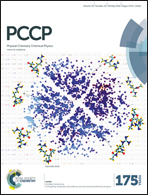Mechanistic insight into the nucleation and growth of oleic acid capped lead sulphide quantum dots†
Abstract
The quantum dots (QDs) of lead sulphide (PbS) are attractive near-infrared (NIR) active materials and have promising applications in a wide variety of applications. Till date many efforts have been made on optimizing its synthesis; however, current mechanistic understanding involving the nucleation and growth of these QDs has not reached the same level as that for other QDs. In this study, we present a detailed understanding on synthesis mechanism of PbS QDs so as to provide guidance for future QDs synthesis. The synthesis of PbS QDs is largely independent of classical nucleation process and the hot-injection of precursors may not be necessary for the successful synthesis of PbS QDs. The synthesis is basically a growth dominated process and is controlled by the Ostwald ripening of PbS QDs. In addition, reaction temperature and ligand are the key parameters for controlling QD growth. Temperature provides energy for overcoming activation barrier of QD growth while the ligands enhance QD growth via altering the environment for QD growth. Following the mechanism governing the synthesis of PbS QDs, we demonstrate that the size tuning of PbS QDs in ultra-small (<2 nm) can be achieved, which has been typically challenging following the hot injection synthesis.


 Please wait while we load your content...
Please wait while we load your content...